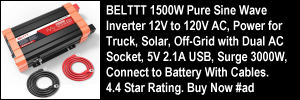We have covered reducing air resistance on a tractor trailer rig on our pages about side skirts and wheel covers.
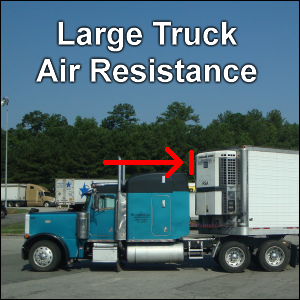 We also seek product reviews on products designed to reduce wind drag like the Airtab and other vortex generators.
We also seek product reviews on products designed to reduce wind drag like the Airtab and other vortex generators.
However, on this page we cover the subject from a rig configuration point of view: tractor and trailer.
We will present the results of our research on this subject — both general and then specifically regarding large trucks — and then list our gallery of photos (with commentary).
Other kinds of rigs — such as those with flatbeds — may or may not be similar to the ones shown here.
General Information about Air Resistance
- “The effect of air resistance is to slow down an object.” (link)
- “Air resistance, also called wind resistance, is the slowing effect air creates on a body as it moves through the atmosphere. … Air resistance is caused by collision with gas molecules in the atmosphere. The greater the number of air molecules, the greater the air resistance. … Semi trucks sometimes have curved roofs to decrease air resistance in the space between truck and trailer, which can have a negative effect on gas mileage.” (link)
- To put this in terms more familiar to Americans, convert 10 meters/second to miles/hour: 22.37 mph.
- Furthermore, this 80-meter wind resource map shows how windy it is across the USA.
- In 9/2006, Volvo Trucks said that air resistance is “a fuel thief.”(1)
- “Aerodynamics is a key factor in optimizing fuel operating costs, and the impact of aerodynamics depends on speed. For instance, the amount of energy required to move the air around a truck at 65 mph is 40% higher than at 55 mph. At 75 mph it is 86% higher.”(2)
- “The power to overcome air resistance increases roughly with the cube of the speed, and thus the energy required per unit distance is roughly proportional to the square of speed.” (link)
- Physics.info’s article on Aerodynamic Drag opens with “The force on an object that resists its motion through a fluid is called drag. When the fluid is a gas like air, it is called aerodynamic drag (or air resistance).”
Air Resistance as it Affects Large Trucks
- CumminsEngines.com’s info on Better Fuel Economy has a link to their technical paper entitled Secrets to Better Fuel Economy.
- GMFleet.com’s 2012 Glossary of Truck Terms at one time defined Air Resistance as: “A measure of the drag or retarding effect due to the air turbulence produced by a vehicle in motion. Because it varies theoretically as the square of the speed, it affects the ability of the vehicle to reach top speed as well as the gradability at fast speeds.”(3)
- Airtab.com shows on its How Do They Work page images of bad and good air flow around a tractor trailer. Notice the high drag areas behind the tractor and behind the trailer in an unfitted unit. Drag is significantly reduced when using the product. The drag at the front of the tractor remains the same.
Trucking Photo Gallery on Air Resistance
We’re going to show you various tractors or tractor-trailer combinations and comment about aspects of them regarding air resistance. Note: we use the term “fins” to refer to the extensions on the back of the and sides of the tractor to reduce the space (and hence the drag created) between a tractor and trailer.
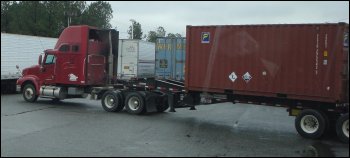 Can you see the huge amount of room between the back of the tractor and the front of the container on the trailer chassis?
Can you see the huge amount of room between the back of the tractor and the front of the container on the trailer chassis?
Reducing this gap — which is at least a third the length of the container itself, maybe longer — can improve fuel economy.
While the shape of the tractor might enable it to slice through the air more easily, the flat front of the container hurts fuel economy.
 Notice how short this tractor is.
Notice how short this tractor is.
The roof of the sleeper does not rise to the height of the exhaust stacks.
The stacks are pointed such that the exhaust exits mostly to the sides.
Any load pulled by this tractor that rises higher than the tractor’s roof will automatically increase drag for the rig.
 Here’s a perfect example of what we’re talking about with regarding the height of a tractor in relation to the height of the trailer being pulled.
Here’s a perfect example of what we’re talking about with regarding the height of a tractor in relation to the height of the trailer being pulled.
Without a windshield to deflect the air, there’s automatic drag.
The refrigeration unit may reduce the wind drag a bit.
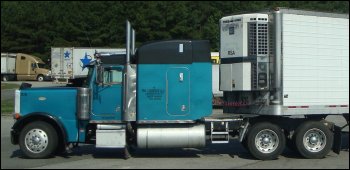 This is another example of a mid-roof tractor with a full-height trailer behind it.
This is another example of a mid-roof tractor with a full-height trailer behind it.
Like the rig above, this tractor has no fairings underneath, but the refrigeration unit may reduce drag a bit, like a nose cone.
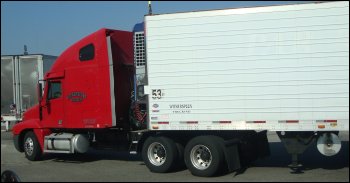 See all of the empty space (devoid of air fairings) under the tractor and under the trailer on this rig.
See all of the empty space (devoid of air fairings) under the tractor and under the trailer on this rig.
At least there are “fins” behind the tractor to try to reduce drag.
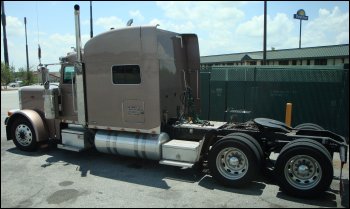 Compared to the tractor immediately above, this one has more equipment under the tractor.
Compared to the tractor immediately above, this one has more equipment under the tractor.
Smoother surfaces would deflect air better.
However, the lower roof might create a situation of resistance with a higher profile trailer (if it pulls one).
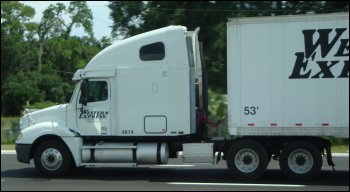 Air fairings could reduce drag on this tractor.
Air fairings could reduce drag on this tractor.
There are “fins” on the back of the tractor, but could vortex generators help even more?
 Notice the difference in height between the tractor and trailer.
Notice the difference in height between the tractor and trailer.
Air that hits the trailer above the tractor’s roof line will cause drag.
There is potential for improvement here.
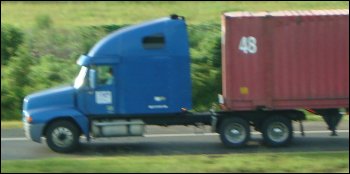 This is another tractor with huge amounts of uncovered space underneath.
This is another tractor with huge amounts of uncovered space underneath.
There are no “fins” on the back of the tractor either.
 Ah! Here’s a tractor with an air deflector up top and air fairings on the sides.
Ah! Here’s a tractor with an air deflector up top and air fairings on the sides.
An improvement might be side skirts on the trailer.
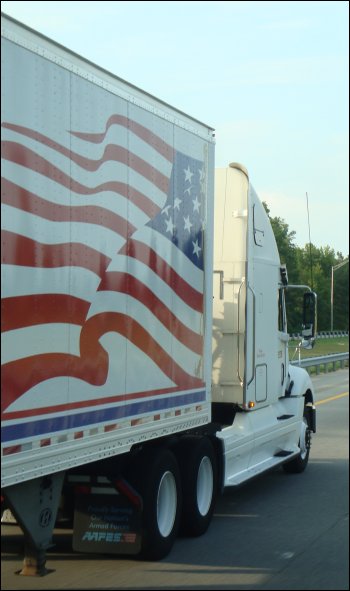 Here is another tractor with air fairings reaching between the steer axle and drive axles.
Here is another tractor with air fairings reaching between the steer axle and drive axles.
Also, the “condo” shape of the tractor not only provides deflection of air over the tractor but increases usable space inside the truck.
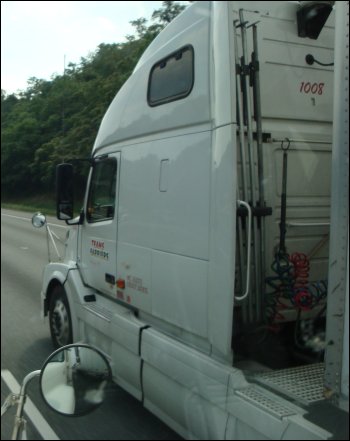 This unit appears to have an extended cab with extra long air fairings.
This unit appears to have an extended cab with extra long air fairings.
There are no “fins” on the back of the tractor.
Drag between the tractor and trailer could be reduced by using a series of vortex generators.
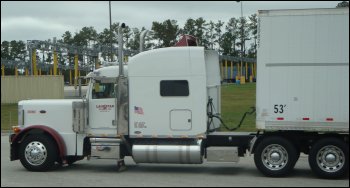 Compare the tractor above with this one.
Compare the tractor above with this one.
See not only the lack of air fairings on the sides but the amount of space between the tractor and trailer.
There is also the height differential between the tractor and trailer.
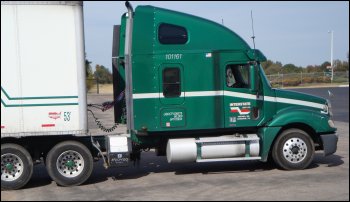 Although this is a tall tractor with “fins,” there are no air fairings under the tractor.
Although this is a tall tractor with “fins,” there are no air fairings under the tractor.
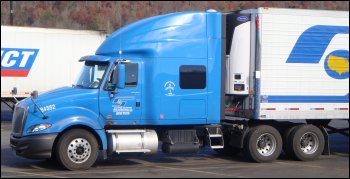 This rig is a similar situation to the one above except that the configuration under the tractor is different and the refrigerator unit on the front of the van may act at least a little like a nose cone.
This rig is a similar situation to the one above except that the configuration under the tractor is different and the refrigerator unit on the front of the van may act at least a little like a nose cone.

Ah, now here’s a tractor with full skirts underneath.
We’re not sure if this type of tractor is suitable for “fins” but we imagine that vortex generators would help reduce air resistance between tractor and trailer.
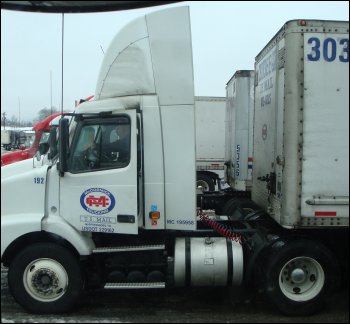 While this day cab has an air deflector up top, there is still quite a bit of room between the tractor and trailer.
While this day cab has an air deflector up top, there is still quite a bit of room between the tractor and trailer.
In other words, even day cabs can improve their fuel economy.

This is definitely the longest wheelbase tractor we’ve ever seen without more stuff between tractor and trailer.
We would guess that there is lots of wind drag on this rig: in the height differential between tractor and trailer, the space between the two and the space underneath the tractor.
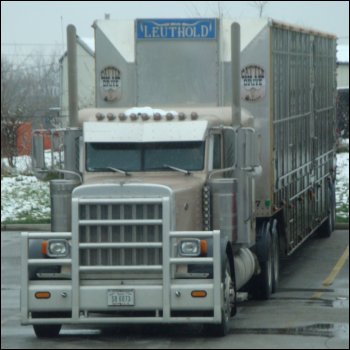 Even cattle haulers are not exempt from problems with air drag.
Even cattle haulers are not exempt from problems with air drag.
Notice the short tractor in front of a tall trailer and the grill guard.
We’re not sure what the impact of the ventilation holes in the trailer would present. Would they increase or decrease air resistance?
(Of course, drag will be influenced by whether the trailer is loaded or not.)
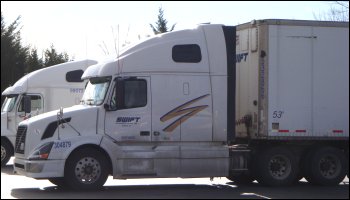 Notice that the air fairings under the tractor go almost all the way back to the drive tires and the “fins” on the back of the tractor significantly “close the gap” between the tractor and trailer.
Notice that the air fairings under the tractor go almost all the way back to the drive tires and the “fins” on the back of the tractor significantly “close the gap” between the tractor and trailer.
The style of fins shown here shows us that they can be put on the backs of tractors where the metal extension is curved.
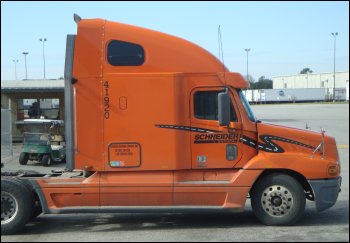 This tractor has side fairings underneath that go all the way back to the drive axles and “fins” behind the cab.
This tractor has side fairings underneath that go all the way back to the drive axles and “fins” behind the cab.
Perhaps adding vortex generators could help reduce air resistance between the tractor and trailers it hauls.
What About Refrigerated Vans?
Although we don’t have any photos of side skirts underneath refrigerated vans, we refer you to
- one (near the bottom of a side skirt thread and which shows not only the reefer’s fuel tank outside the side skirt but an additional skirt between the separated trailer tandem axles)(4) and
- the photos of the Safeway refrigerated vans.(5)
![]() Money saving tip: Since air resistance is a great fuel consumer, whatever professional truck drivers and their trucking companies can do to reduce it on their trucks means improved fuel economy and hence money saved on truck operations.
Money saving tip: Since air resistance is a great fuel consumer, whatever professional truck drivers and their trucking companies can do to reduce it on their trucks means improved fuel economy and hence money saved on truck operations.
Look for all of the areas where there is wind drag on your truck — such as
- the height differential between tractor and trailer,
- under the tractor,
- between the tractor and trailer,
- between multiple trailers, and
- behind the trailer
— and seek to reduce it.
Separately, there are wheel covers to reduce wind drag on truck wheels.
Using multiple products (for each of the places where drag occurs) may be your best option for maximizing savings.
Return from Large Truck Air Resistance, Fuel Economy and Efficiency to our Truck Operations page or our Truck Drivers Money Saving Tips home page.
Reference:
1.
magazine.volvotrucks.com/global/Articles/International/2006/09/Air-resistance–a-fuel-thief/Air-resistance–a-fuel-thief/
(no longer online)
2. www.kenworth.com/Kenworth_White_Paper.pdf (no longer
online)
3. www.gmfleet.com/content/dam/gmfleet/global/master/nscwebsite/en/Home/Shared_Resources/PDFs/2012_Glossary_of_Truck_Terms.pdf (no longer online)
4. hankstruckforum.com/htforum/index.php?topic=47662.30 (no longer online)
5. hankstruckforum.com/htforum/index.php?topic=9050.135 (no longer online)








